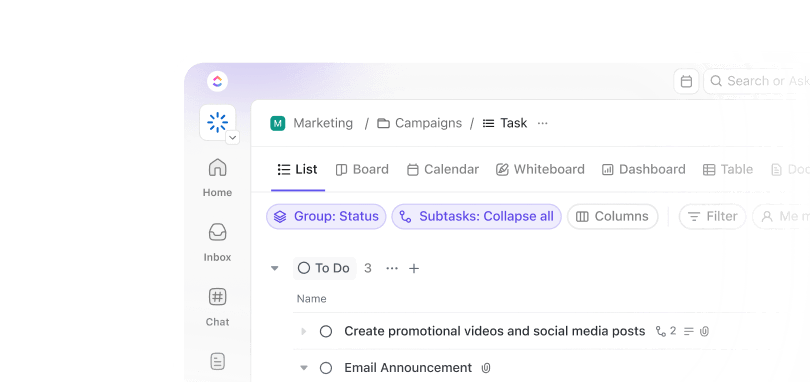What makes you stop scrolling and watch a video?
It’s not the production value—it’s how the message connects. A well-written script can turn even a simple concept into something memorable when done right.
In this blog post, we’ll explore how to write a script for a video that keeps your viewers watching and leaves a lasting impression.
Let’s get started! 🎯
How to Write a Script for a Video That Engages Viewers
⏰ 60-Second Summary
- A video script is a planning document outlining the narrative and message of your video. It includes dialogue, visual descriptions, scene directions, and editing notes
- Steps for creating an effective video script
- Clarify your goals to define what you want your video to achieve
- Identify your target audience to ensure the video resonates with them
- Develop an outline to structure your video into beginning, middle, and end
- Write the script focusing on a hook, storytelling, and conciseness
- Edit, revise, and finalize the script with feedback from peers
- A clear script keeps the message focused and supports creativity
- Relying on productivity platforms like makes the scriptwriting process faster and more efficient
- Use Whiteboards and Docs in to organize and collaborate on your scripts
- Brain, ’s native AI, can assist in refining script ideas and enhancing the quality of your writing
What Is a Video Script?
A video script is a structured planning document that outlines the narrative and message of a video. It guides the reader through all production stages, from ideation to post-production editing.
Think of it as the blueprint of what will be said and shown, including dialogue, actions, and visual elements, ensuring clarity and organization throughout the filming process.
Here are some key components of a video script:
- Dialogue: Spoken words of characters or voiceovers
- Visual descriptions: Details about on-screen actions, settings, and graphics
- Scene directions: Instructions for performers and camera work
- Editing notes: Guidance for post-production adjustments
Video scripts are formatted differently depending on their purpose. For example, entertainment scripts rely heavily on dialogue and scene details, while commercial scripts often use a two-column layout to map out audio and visual elements for smooth production project management.
🧠 Fun Fact: The first video ever uploaded to YouTube was titled ‘Me at the zoo’ and was uploaded by co-founder Jawed Karim in 2005. It’s a simple 18-second video that spawned the platform’s massive growth.
Why do you need a video script?
A clear video script keeps your message clear, ensures your visuals align with your story, and saves time during production. Let’s look at why you need a script:
- Keeps things on track: It lays out the plan, ensuring your story flows logically and stays focused
- Ensures clarity: Scripts help you nail key points and keep everyone, from solo creators to teams, aligned on the message
- Supports creativity: With the structure in place, you can focus on adding creative touches that make your video shine
- Boosts quality: A well-crafted script leads to more engaging, personalized videos that resonate with your audience
🔍 Did You Know? Video scripts date back to the early days of cinema. The first movie script was written for the 1902 film A Trip to the Moon.
How to Write a Video Script
Writing a detailed script might sound daunting, but it doesn’t have to be.
You must break the process into manageable chunks that guide your ideas from a rough concept to a polished story. Whether you’re writing scripts for publicly shared YouTube videos or in-house videos for your company, you can start with simple tools like Google Docs.
If you’re looking for tools that let you optimize your content creation workflow, from brainstorming ideas to finalizing your video script, in one place, you can opt for a platform like .
is the everything app for work that brings your projects, docs, tasks, and chat together in one powerful AI-driven tool. It streamlines project management, collaboration, and communication for teams of all sizes.
Let’s walk through a step-by-step guide to creating your own video script using as a video marketing software. 👇
Step #1: Clarify your goals
Identify what you want your video to achieve. Do you want to educate, entertain, or persuade? A clear objective guides your script.
Take it a step further by deciding on the action you want viewers to take after watching. This could be anything from visiting a website or subscribing to your channel, to signing up for a service or making a purchase. The more precise your goal, the easier it is to craft a compelling call-to-action (CTA).
📌 For example, instead of a broad video marketing goal like ‘boost engagement,’ you could aim for something measurable, such as ‘encourage 50 comments on the video within 48 hours.’
Step #2: Identify your target audience
Analyze your audience deeply to ensure the video resonates. Consider their demographics, such as age, gender, location, profession, and preferences. Go beyond surface-level details to explore their interests, pain points, and motivations. Understanding these aspects helps you connect with them on a more personal level.
Gather actionable insights using tools like surveys, social media analytics, and website data. If you’re targeting professionals, consider their industry trends and challenges.
Adapt your script based on this research. Speak their language, use examples they relate to, and address their needs directly. A casual and energetic tone works well for younger audiences, while professionals may prefer concise and data-driven messaging.

Whiteboards are a visual tool that lets you map out your ideas in real time—perfect for storyboarding, content flow, or even jotting down key script points. Its integration with Tasks means every concept can be transformed into actionable steps without switching platforms.
Start with a blank Whiteboard and sketch out your video concept—add visuals, text bubbles for dialogue, and arrows to show transitions.
Collaborate with team members live to refine the flow, then link your Whiteboard directly to a Task for easy reference during production. With options to export or share, your entire team stays aligned from start to finish.
⚙️ Bonus: Try storyboard templates in Whiteboards to plan your video’s flow. These templates help organize key scenes, ensuring a clear structure and smooth transitions.
Step #3: Develop an outline
Break your video into clear sections: beginning, middle, and end. Each section serves a specific purpose, so defining these parts early ensures your story flows logically and keeps viewers engaged.
In the beginning, introduce your topic and grab attention immediately. Use an intriguing question, bold statement, or compelling fact to hook viewers. The middle section should deliver the core message, breaking it into smaller, easy-to-follow points that build on one another.
Conclude with a strong finish that reinforces your key message and prompts the desired CTA.
📌 For example, if you’re explaining a process, break it into clear steps and allocate them to the middle section. Adding specific examples or data for each section strengthens your message and makes the content more relatable.


Docs are an excellent tool for drafting, organizing, and collaborating on video scripts. Integrated within , the feature helps you manage your scripts alongside other project tasks, ensuring everything stays in one place.


Nested pages in Docs are great for breaking your script into different sections, like scenes or acts, without creating multiple, disjointed documents.
For example, if you’re drafting a script for an explainer video, you could create a main document titled ‘Explainer Video Script’ and use nested pages for each part of the video, like ‘Introduction,’ ‘Core Features,’ and Call to Action.’
Here’s a fun entertainer explainer video we made for Docs!
You can also embed external content, such as reference how-to videos or research documents, directly into Docs using slash commands.
💡 Pro Tip: Collaborate on your video script with real-time editing in Docs. Team members can refine the script together, leave targeted feedback through comments, and tag others for input. Use version history to track changes and restore earlier drafts if needed.
Step #4: Write the script
You can start writing the video script now. Here are some key points you must remember:
- Start with a hook: Open with a statement, question, or idea that grabs attention and makes viewers want to keep watching
- Engage with storytelling: Use relatable stories or examples to create an emotional connection with your audience
- Keep it concise: Stick to the essentials. Clear, focused writing holds attention better than unnecessary details
Brain, an AI-powered assistant within the platform, can refine your script ideas and enhance your writing. It connects insights from tasks, documents, and team members, providing real-time assistance to keep video production organized and efficient.


Plus, it can generate content based on your prompts, assist with rewriting, or summarize long sections of text to make your script more concise. This is a big time-saver, especially during the drafting and revision stages.
For instance, in the example above, we’ve asked the AI script generator to write a 60-second video script for a product demo for a handheld vacuum cleaner.


Step #5: Edit, revise, and finalize
Edit and revise your script until it’s perfect. Reading your script aloud helps identify awkward phrasing or areas where the flow feels off.
Before finalizing it, share it with peers or team members for constructive input.
This feedback can help you tweak and polish your script until it feels right. Then, you can start prepping for production. Ensure everything you need for filming, including locations, props, and visuals, is ready.


Using Clips, you can record your screen and voice to capture ideas, feedback, or instructions instantly. This makes it perfect for crafting video scripts or planning visual and audio elements.
Instead of lengthy emails or unclear notes, Clips allow you to show exactly what you mean, ensuring clarity and saving time.
Suppose you’re brainstorming for a video script. You can record a Clip while walking through an outline or storyboard. Highlight important visuals, discuss tone and pacing, and share your thoughts directly with your team.


With AI transcription, every word in your Clip becomes searchable, so no detail is lost.
🧠 Fun Fact: The first viral video, The Dancing Baby, appeared in 1996. It’s a 3D animation that quickly gained popularity through email and was one of the first examples of internet culture.
Tips for Writing Great Video Scripts
When crafting a video script, the key is to keep your audience engaged from start to finish. Some specific tips and techniques can make your script stand out, whether you’re creating an informative explainer, a promotional piece, or an entertaining video.
Let’s look at a few. 👀
- Limit sentence length: Aim for 3-4 sentences per scene. This keeps the content engaging and prevents viewers from losing interest
- Write in the present tense: Use this to create urgency. It makes the content feel immediate, helping capture and maintain viewer attention
- Edit ruthlessly: Take a break and return to your script for revisions after rewriting. Remove unnecessary words or scenes that don’t add value
- Include transitional phrases: Use phrases that smoothly connect different ideas, helping maintain flow throughout the script
- Script every word: Avoid relying on bullet points or outlines alone; scripting every word ensures clarity and reduces the need for retakes during filming
Another excellent tip is to pick a specific storytelling framework to structure your video project. Here are some common options:
- AIDA: Focus on Attention, Interest, Desire, and Action to guide viewers toward a specific outcome
- PASTOR: Address a Problem, Agitate the issue, present a Solution, and offer Testimonials and a Response
- PAS (Problem-Agitate-Solution): Highlight a problem, intensify the urgency, and provide your solution
- Explainer video script: Outline the problem, solution, how it works, core benefits, and conclude with a call-to-action
🧠 Fun Fact: In 2013, YouTube introduced its autoplay feature, which allows videos to play the next video in the line-up automatically. This feature has increased viewing times and encouraged binge-watching.
Script Your Success With
Writing a script becomes manageable with the right tools and a precise approach.
Ultimately, your focus must remain on knowing your goals, understanding your audience, structuring your content, and keeping things concise to create a script that holds attention.
When it comes to organizing your ideas and collaborating with your team, , the everything app for work, has your back. Whether you’re drafting your script, outlining ideas, or sharing feedback, ’s features, like Brain and Docs, help keep everything streamlined and efficient.
Sign up to for free today! ✅


Everything you need to stay organized and get work done.











